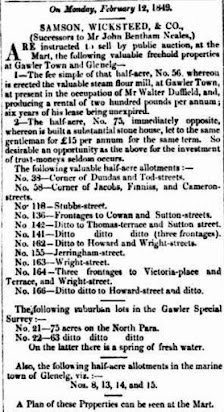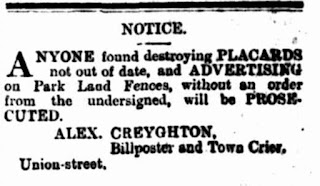Old Bill Taylor – Gawler Town Crier
First shared on ‘Gawler: Colonial Athens’ blog, 9/2/2021
William Taylor was born in Buckinghamshire England in May 1818. He married Mary Hillsdon (1817-1879) in 1839.
Their children Ann, Sarah and John were born in England, and Hannah and the children following were born in South Australia. Their children were:
Ann Taylor (1840–1840), Sarah Taylor (1842–1921), John Taylor (1844–?), Hannah Taylor (1847–1849), Elizabeth Taylor (1849–1866), Lucy Taylor (1850–1924), Thomas Henry Taylor (1851–1911), Lydia Mary Taylor (1854–1917), William Richard Taylor (1857–1933), James Taylor (1859–1864).
William Taylor was known around Gawler as ‘Old Bill’. He was a local Town Crier.
A 1925 The News article reported the following on Gawler Town Crier ‘Old Bill’ Taylor,
In its early days Gawler possessed a town crier, who combined poetry with oratory. For the poetry he made an extra charge. When announcing a sale at a building where its solitary room was used for religious services, and the collars as a store for wines, the crier was frequently heard to recite the foIlowing lines, much to the amusement of the public:
"There's a spirit above and a spirit below,
A spirit of weal and a spirit of woe,
The spirit above is the Spirit Divine,
The spirit below is the spirit of wine."
The verse above is a quotation from Anna L Wards Dictionary of Quotations written by “MS”. It was written about 1825 about the vaults below Portman Chapel, Baker Street, London.
Old Bill Taylor commentated on the 1869 election vote between Samuel Bradley and David Thompson. As printed in the Bunyip at the time (and later reprinted in 1932):
Gawler In Other Days
Only 28 ratepayers voted on Wednesday last in the contested Ward (South)
No one seemed to take the least activity hunting up voters for the involuntary candidates, and nothing tended to show that any election was going on with the exception of the town crier, Mr. William Taylor who perambulated the Ward read the following notice, which he has left with us for publication, that his name may be emblazoned on the herald of fame as one of local laureates:
To all the electors of South Ward.
Haste to the pool and quick record
Your votes for Dave or Sam;
If Dave is elected, you will place
The saddle on. him who won the race;
But if for Sam you vote.
You'll send in one who soon will prove
That public interests him move,
He'll never turn his coat.
You that have not voted in this Ward,
I hope you'll come in time;
I think you will not judge me hard.
For it will enhance the rhyme,
You know that for the contest
There's two, that's Dave and Sam.-,
Now all take your opinions
And vote for the best man,
Because there is no botheration
In being one of the Corporation.
The result showed— Samuel Bradley, 20; David Thompson, 8. Dec. 4, 1869.
In 1871 Mr John Knowles proposed that Town Crier, William Taylor run for Council.
Old Bill Taylor died on 4 February 1876 while walking from the Gawler Railway Station towards Murray Street.
SUNSTROKE: Mr. W. Taylor, our bill sticker and town-crier, received a sunstroke today about noon while in the occupation of his duty. He was travelling between the Railway Station and Gawler, and was observed to fall down. Dr. Popham was in immediate attendance and did everything possible for his recovery. He died about 3 o'clock, to-day, just as we Were going to press.
William Taylor is buried at St George’s Cemetery, Cheek Avenue, Gawler East.
Researched and written by Allen Tiller © 2021
[1] 'GAWLER COUNCIL', News, (25 November 1925), p. 6.
[2] 'CORRESPONDENCE.', The Register, (29 October 1910), p. 4.
[3] 'GAWLER IN OTHER DAYS.', Bunyip, (20 May 1932), p. 10.
[4] 'MUNICIPAL ELECTIONS.', Bunyip, (25 November 1871), p. 3.
[5] 'BAROSSA MINING NEWS.', Bunyip, (4 February 1876), p. 2.
















